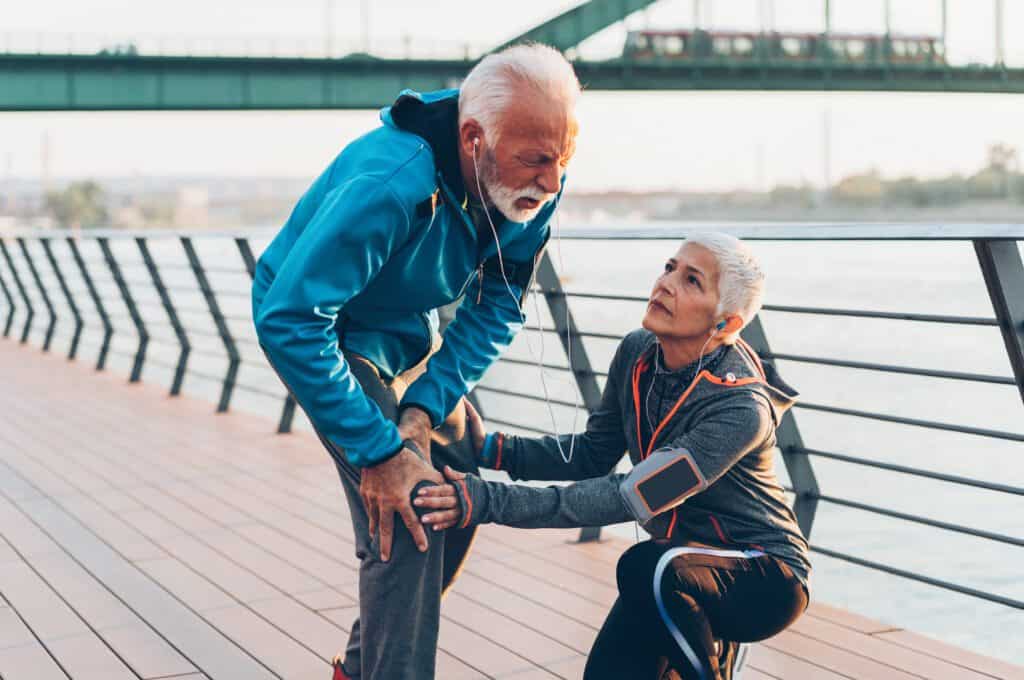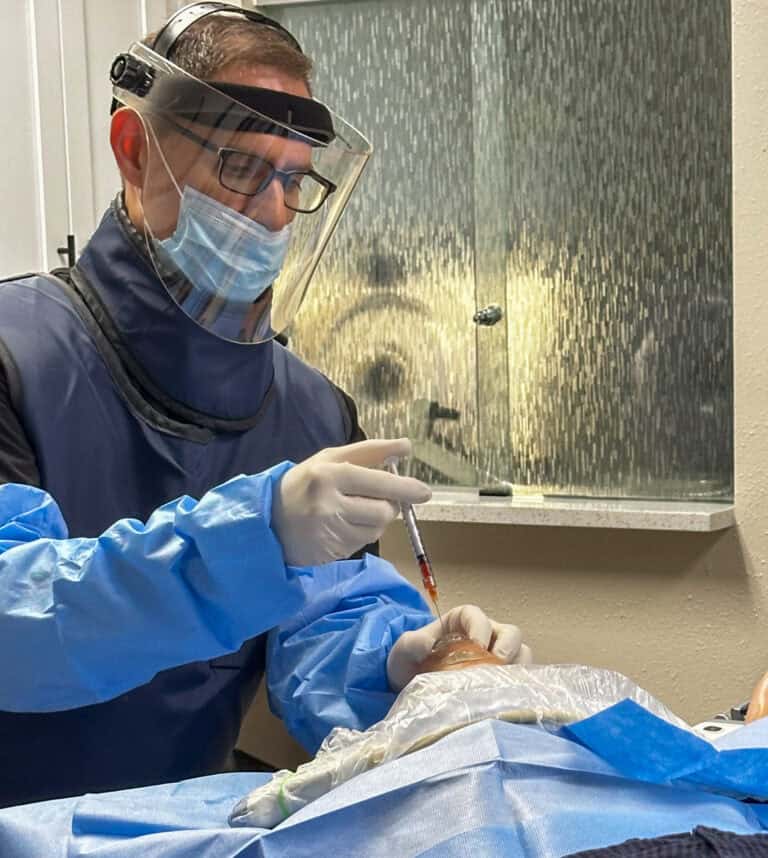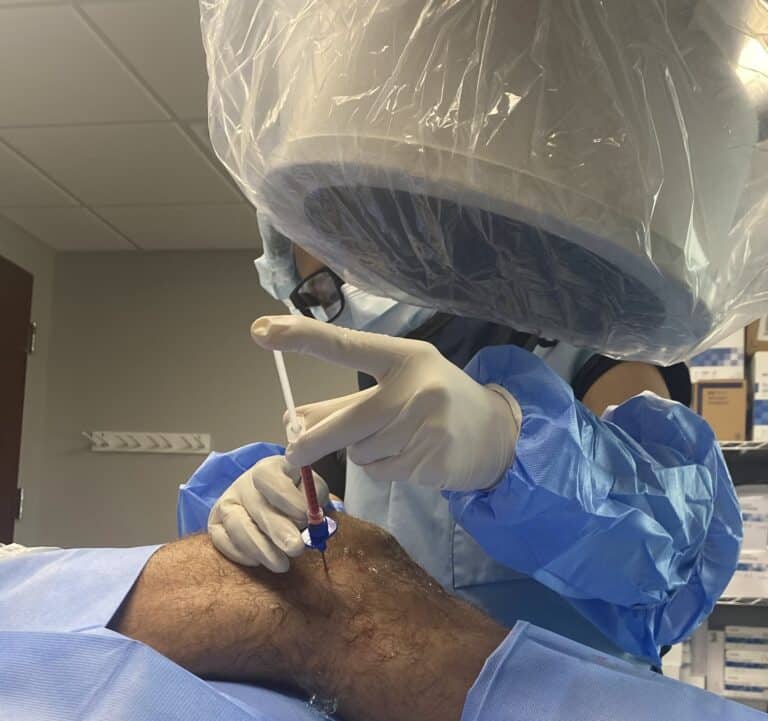As runners age, they often develop injuries that can limit their ability to keep hitting the pavement. Runners then fall into one of two camps: they’re able to keep running or they accumulate too many issues and end up hanging up their sneakers.
What are the leading causes of knee pain in runners? And how can you improve your chances of being able to keep running beyond middle age? Read on.
Injury to the Hip or Low Back
Is your pain localized on your kneecap? It might actually be a result of your hip and low back mechanics, even if you don’t feel any discomfort in those areas.
The hip and gluteal muscles (or buttocks) have a complex relationship with the knee joint. If the gluteal muscles aren’t strong enough or react slowly, excess strain will be placed on the kneecap. This is because they work in conjunction with the quadriceps to support the leg and pelvis at each step during a run.
Slow firing of the gluteal muscles will lead to over contraction of the quads. When this happens repeatedly over a period of time, the strain on the kneecap can cause pain and eventually can erode the cartilage under the kneecap.
The gluteal muscles also help stabilize the low back and have a symbiotic relationship with deep low back muscles called the multifidi. A low back injury or improper biomechanics could mean that your multifidi muscles, which stabilize the spine, have stopped firing.
When this happens, other muscles will take over trying to do the multifidus’ job, even if they aren’t as equipped. The result is often back tightness that can have a downstream effect on running form and ultimately lead to injuries of the back, hip or knee.
Injuries of the Ankle Ligaments and Tendons
Injuries of the ligaments or tendons can also bring about knee pain in runners. Ankle ligament instability can be a result of a previous ankle injury and can often lead to further injury of the ankle or cause injuries up the chain at the knee or hip.
Why would ankle ligament instability harm your knee? It’s a matter of all parts of your body being connected to each other. If your ankle hurts, you might change the way you run to lessen the pain in your ankle. Additionally, if the range of motion of the ankle is restricted while running, more strain and impact will be placed on the knee and hip.
What are the Potential Injuries to the Knee?
Your knee is made up of several different components: ligaments, tendons, the meniscus, bone, and cartilage. If any of these suffer an injury, you could face painful consequences. Let’s review each of these in-depth:
Ligaments: Your ligaments connect and support the knee bones. You might have heard of some or all of these: the ACL (anterior cruciate ligament), PCL (posterior cruciate ligament), MCL (medial cruciate ligament), LCL (lateral cruciate ligament) and ALL (anterolateral cruciate ligament).
A tear or strain to any of these might result in knee popping, shifting or clicking, indicating instability. This, in turn, can incur more injuries to other parts of the knee joint, such as the meniscus and the bone. So, it’s vital that any loosening or damage to the ligaments is caught early.
Unfortunately, orthopedic surgeons primarily focus on ligament injuries that require surgery because of a completely ruptured ligament and may not be as attuned to more minor, yet still significant ligament injuries.
Tendons: Running can do a number on your knee’s tendons. Between the hamstrings posterior to the knee, the pes anserine tendons on the inside of the knee, the popliteus at the rear and on the outside of the knee, the ITB on the outside and, last but not least, the quadriceps in the front the knee is supported by many important tendons.
As you get older, they can wear down or become swollen and overworked leading to tendinopathy or tendon tear injuries.
Meniscus: The meniscus plays a lot of important roles for your knee: shock absorber, cartilage protector, stabilizer. A meniscus tear, commonly found during an MRI or ultrasound examination of the knee, can be a common source of pain or clicking and popping for runners.
However, your physician should have a high degree of suspicion before attributing pain to a meniscal tear, as these can also be present without causing any symptoms. Over the past 10-15 years there has been a growing number of studies, including this one, that shows surgical procedures to be no better than physical therapy or sham surgery for meniscus tears. In fact, removing meniscus tissue associated with surgery has been shown to accelerate osteoarthritis and worsen the health of the knee long term.
Bone and Cartilage: Bone and cartilage, are actually made of similar tissue, but have slightly different jobs to do. Cartilage cushions the knee bones, while the bone gives strength and resistance to impact. Runners frequently suffer from cartilage that becomes worn or torn. When this happens, the bone can swell in response to the injury. If damage to the bone becomes severe the blood supply to the bone may be compromised and result in osteonecrosis or “dead bone.”
How to Prevent Running Injuries
Keep these four pieces of advice in mind so that you can remain a runner as you get older:
1. Maintain a healthy weight. A lower weight equals less stress on your body’s joints.
2. Pay attention to your body. Don’t wait until minor injuries become severe to seek treatment. An ounce of prevention is worth a pound of cure.
3. Be very cautious about surgery and cortisone. A number of surgeries for knee injuries, like meniscectomies, have very little evidence to support their use over conservative measures and have been shown to accelerate osteoarthritis. There is a similar story here with regard to cortisone injections. While cortisone injections can cause a temporary decrease in pain, they are toxic to cartilage and likewise have been shown to accelerate the formation of arthritis in the knee.
4. Consider a regenerative procedure when a candidate. Platelet Rich Plasma (PRP) and bone marrow concentrate injections have been shown to improve the health of the knee joint and stave off the arthritic process, even in patients with advanced osteoarthritis in multiple studies. When used appropriately, these procedures are designed to give the aging runner the best chance to stay on the pavement.
Running when middle-aged and older is possible. You just need to be aware of potential pitfalls and preventions in regard to knee pain. Being proactive could prevent the onset of knee pain and other issues. If this is something you currently experience, contact us today to find out if you’re a candidate for a Regenexx procedure.










